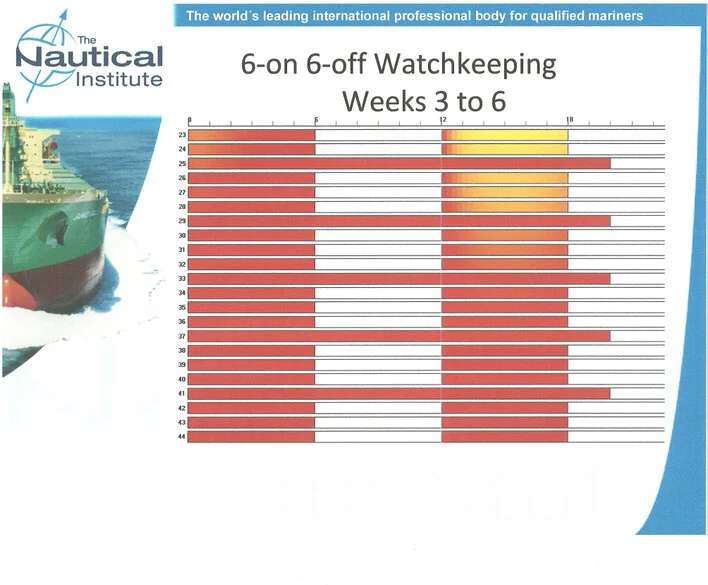rest hours slides
archive > archive presentations

25th September 2012
Compliance with Seafarers Hours of Work and Rest
As one of your Branch members – thank
you Arthur Bowring – wrote in the ALERT bulletin some 6½ years ago (January 2006) –
“It is now quite clear, despite the obstinacy from those that should know
better, that fatigue is a major issue with many of those who work at the front
line in our industry - our seafarers. As
fatigue is primarily caused by tiredness through overwork or stress, the
natural answer to the problem is to amend or replace the present regulations so
that there will always be a sufficient number of competent people on board
every ship.” He also wrote an article in Seaways in March that year on Minimum
Manning Levels – why they aren’t working.

In the last President’s
Questionnaire one of the areas of greatest concern to the membership was
manning levels. The NI strategic plan 2011-15 identified the objective of the
elimination internationally of the Master/Mate two watch system.

We maintain that the practice is
intrinsically unsafe and that ships will continue to run aground or have
collisions due to the fatigue of the officers. The NI will seek to ensure that
there ar sufficient, qualified and competent watchkeepers and lookouts to safely operate the ship at all
times and in all conditions within the hours of work and rest regulations.
Our main concern on the Master/Mate
two watch system focuses on the ability of the Master to respond to any
situation outside of his watch and the need for a second watchkeeper
to support other watchkeepers. We will be submitting
a paper to IMO next year on this issue and would seek input from branches on
any instances of accidents or near-misses which can be attributed to this
practice.
There
have been several recent studies on the issue of fatigue and as you are
probably aware,Project Horizon, the project on
research into the effects of sleepiness on the cognitive performance of watchkeepers under different watch patterns was carried out
last year. One of the aims was to determine the effects of watch systems and
components of watch systems on fatigue. The programme was designed to ensure a
high degree of authenticity, including variable workloads, port visits, changes of orders, mandatory reporting points and passing
traffic. Participants working the 6/6 watch system were found to get markedly
less sleep. Among the findings, Project Horizon suggests that owners,
regulators, seafarers and others should pay special attention to the potential
risks in difficult waters in combination with the 6/6 watch system, night
watches, the last portion of the watch and watches after reduced sleep
opportunity

The MAIB commissioned a study in 2004
to establish the principal factors that cause accidents. This study found that
minimal manning, consisting of a master/mate as the only two watchkeeping officers on vessels operating around the UK

A third
of all the groundings involved a fatigued officer alone on the bridge at night.
Fatigue was considered to be a contributory factor in 82% of the groundings in
the study, which occurred between 0000 and 0600 and in 90% of these the vessels
carried only two bridge watchkeeping officers. This
data highlights the link between small dry cargo ships operating in the short
sea trade, manned with just two deck officers, and groundings caused by
fatigue. Ships which grounded as a result of a sole watchkeeper
falling asleep at night through fatigue, were manned
in accordance with their safe manning certificates and all had just two watchkeepers, a master and a mate. This, together with the
fact that a significant number of vessels manned to the same level, were
involved in collisions when the watchkeeper was alone
on the bridge in conditions which merited additional manning, raises serious
doubt on the justifications for operating vessels with just two bridge watchkeeping officers. The increased propensity for watchkeeper fatigue, on ships within the short-sea trade
which are operating with just two bridge watchkeepers,
is a key indicator of the inadequacy of such manning.
Other
transport modes, especially aviation, have excellent predictive tools. The MAIB
Study used one with a marine work profile – with astonishing results.
This slide shows that cumulative fatigue that develops over a three
week period for the chief mate working 6on 6 off on a ship that is in port
every 4 days. Fairly artificial scenario – many ships that operate around our
coasts are in port more often and the ability of this officer to get his rest
is even less. However, even under these conditions, fatigue accumulates
overtime such that by day 22 its impact is critical.
If you
extend the period a further 3 weeks you can see that, using this tool designed
for airline personnel, the situation becomes very bad indeed
Even if
we accept that working in excess of 90 hours a week is safe, this cannot be
achieved unless the vessel is manned sufficiently for the operation it is
conducting. Just looking at bridge watchkeeping
officers, in addition to manning the bridge – when STCW requires then not to be
distracted from their watchkeeping duties – they have
cargo checks, maintenance and safety routines, administrative duties,
supervising hazardous operations, ever increasing paperwork, pilotage, berthing duties, loading and unloading, harbour
inspections and the list goes on. And that’s before we consider security.

Another,
but equally important aspect, is the ability of a
master to undertake the functions required of the command when involved in such
a demanding and disrupted watchkeeping pattern. In
fact, where the master is employed as one of two watchkeeping
officers, he has little choice in this respect. When at sea, working a watch on
– watch off routine on the bridge, a master cannot fulfil his obligations
without disruptions to his own patterns of rest, which are already disrupted by
voyage cycle times. As ships operating with just two bridge watchkeepers
including the master, working in opposite watches, are likely to have fatigued OOWs, and the masters of these vessels are frequently
unable to discharge all of the duties required of them, the need for more than
two watchkeepers is obvious.
Most
conscientious owners and managers are now increasing the numbers in their
crews, as they recognise that the trend to minimum manning has gone too far.
However, there are still some people in our industry who consider the minimum
safe manning certificate to be their crewing level, regardless of the trade
their ship is involved in – and, even worse, they often barter between flags to
see who will allow them the lowest numbers.
Since then there have been other incidents
involving groundings of vessels where the principal cause was the sole watchkeeper falling asleep as a result of fatigue.

Here is
the case of the Antari where the officer of the watch
had fallen asleep shortly after taking over the watch at midnight when the
vessel was passing thepeninsula ofKintyre (Scotland

Surprisingly,
we have been lucky so far. These groundings have all occurred without any
apparent pollution. Just think if this vessel had proceeded down theIrish Sea and collided with one of the oil rig platforms.
September 2007, The
general cargo ship Fingal was carrying a cargo of
timber, when she grounded onSanda
Island , south of the Mull of Kintyre,
whilst on passage from Campbeltown toLondonderry . There were calm conditions and good
visibility. The master had been on watch alone and had fallen asleep after
making a course alteration, some 20 minutes before the grounding. This vessel run aground again in Dec 2009 on theisland ofJura

NI Fatigue Forum – fatigue reports
including some from Baltic, where, in addition to 6on6off, the Master is
frequently called on to do the pilotage where he has
an exemption certificate. Also in some ports e.g. Hamburg
This has been a brief run through of
some of the issues with the Master/Mate two watch operation
and as I said at the beginning, any input to help in our paper to IMO is most
welcome
Thank you


